| Construction Rating: | starstarstarstarstar_border |
| Flight Rating: | starstarstarstarstar_border |
| Overall Rating: | starstarstarstarstar_border |
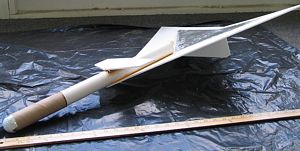
Brief:
An upscaled boost-glider from AstronMike.
Construction:
Mike Kochel (aka "AstronMike") surprised me at a recent launch by handing over a plastic grocery sack of
parts and large sheet of foamboard saying, "Here, go build this!" I've always been in awe of Mike's gliders,
not just the sheer size, but also how well they fly. I welcomed the opportunity to try one on for size.
The three and a half pages of instructions include an introductory section describing the kit as Mike's 3x upscale "of an old Estes plan called the Eagle." That original 1964 Design Contest winner can be found on the JimZ site. Mike has made a few changes and improvements to the design.
The parts bag included (of all things) a golf ball, a tremendously short piece of elastic, instructions, and several tubes. The foamboard was pre-marked with pattern outlines of a large wing, a smaller canard, rudder and some bulkheads. I suspected the simplicity of the parts somehow hid an underlying bit of complexity, but I was wrong.
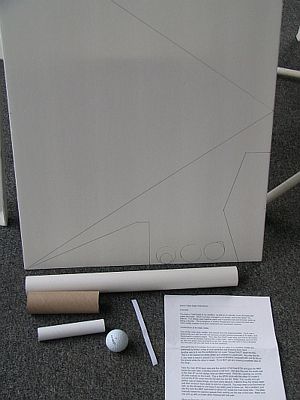 The instructions lack pictures or illustrations, but those are not really necessary. After
cutting out the foamboard parts, construction was extremely straightforward. The motor mount and main body tubes were
glued together. The golf ball was attached (with Gorilla glue) to the forward tube section. After these assemblies
dried, the bulkheads and shock cord were added. Since the forward nose section completely separates from the glider,
the short length of elastic is all that is required. It's not mentioned in the instructions, but I recommend wicking in
a touch of thin CA along the tube edges. This will help protect the exposed portions from wear and tear.
The instructions lack pictures or illustrations, but those are not really necessary. After
cutting out the foamboard parts, construction was extremely straightforward. The motor mount and main body tubes were
glued together. The golf ball was attached (with Gorilla glue) to the forward tube section. After these assemblies
dried, the bulkheads and shock cord were added. Since the forward nose section completely separates from the glider,
the short length of elastic is all that is required. It's not mentioned in the instructions, but I recommend wicking in
a touch of thin CA along the tube edges. This will help protect the exposed portions from wear and tear.
The main wing needs a few inches of dihedral and Mike suggests a couple of methods to accomplish this. I came up with an alternative, using a corner of my closed safety knife along a metal straight edge. The trick is to compress the foamboard without cutting through it, then using this crease to bend the wing.
Using the dihedral crease as a guide, the body tube and underside rudder are easy to align and glue in place. I offset the rudder by the width of the foam to induce a slight right turn to the glide path. I've seen Mike walk most of a mile to retrieve his gliders and didn't want to repeat that experience! Aligning the canard was probably the most complex portion of the build--it sits on top of the body tube and needs to be perpendicular to the tube centerline and level with the main wing.
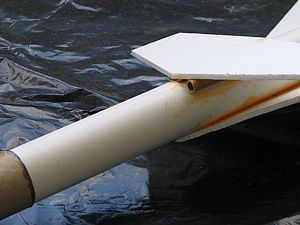 Mike did not include a parachute or launch lug, knowing that any respectable parts bin or
range box already contain these items. I used a 1/4" igniter tube and glued it along the canard instead of the
main wing/body joint. This will keep the rod off the wing and away from the aluminum foil blast protection. I elected
to use an oversize triangle of heavy-duty foil simply to add some contrast/color to the large wing area. Smaller strips
of aluminum tape could also be used.
Mike did not include a parachute or launch lug, knowing that any respectable parts bin or
range box already contain these items. I used a 1/4" igniter tube and glued it along the canard instead of the
main wing/body joint. This will keep the rod off the wing and away from the aluminum foil blast protection. I elected
to use an oversize triangle of heavy-duty foil simply to add some contrast/color to the large wing area. Smaller strips
of aluminum tape could also be used.
Finishing:
The large wing area and inherent CG location makes trimming this design much easier than most traditional boost
gliders. The Astron Triple Eagle retains the expended motor which sits directly above the glide CG location. Initial
backyard hand tossing revealed my build needed no additional weight.
Construction Rating: 4 out of 5
Flight:
Despite my initial success with backyard trimming, the first flight resulted in a parabolic recovery of the glider.
The D12-3 boost was gorgeous! Perfectly straight up with just a single half-roll on the way to 250' or so. That roll
aligned the wing with the wind, making it difficult to pull out.
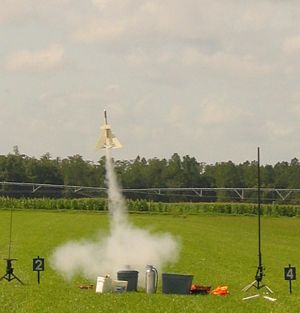 The nose and chute blew at the top, so 3 seconds is the right choice for the delay. The
nose ballast recovers under chute and I found a nylon 15" chute to be sufficient.
The nose and chute blew at the top, so 3 seconds is the right choice for the delay. The
nose ballast recovers under chute and I found a nylon 15" chute to be sufficient.
After adding three 1/4" washers to the rudder, the CG moved to the aft-end of the main tube and leading edge tip of the rudder. This resulted in a just slightly lower boost but a perfect flight.
A third flight in a minor breeze (compared to the second flight conditions) yielded another nose down ballistic glide. I suspect just a little more trim work will provide good results in all wind conditions.
Recovery:
Once properly trimmed, the glider recovers very gracefully! One flight in little to no wind resulted in a lazy glide
to about 18 inches, where it stopped and dropped in just like a Harrier Jump Jet.
Flight Rating: 4 out of 5
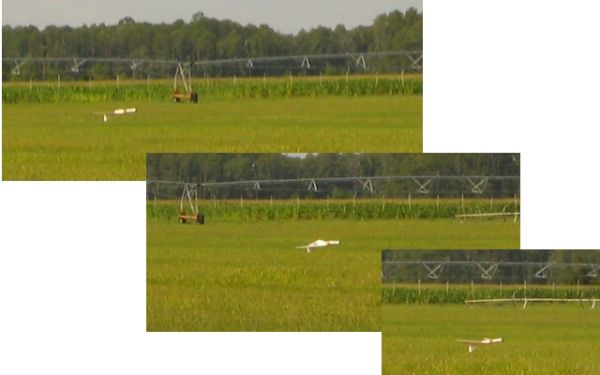
Summary:
I don't know if Mike intends to publish plans or offer kits of the Astron Triple Eagle, but I hope that others will
get the opportunity to build and fly this great glider. Using a golf ball for the aerodynamic nose cone and boost
weight is an ingenious feature! The only downside I can find fault with is the large size makes storage a challenge.
The wing span approaches the fin size of some HPR rockets.
Overall Rating: 4 out of 5
 |
 |